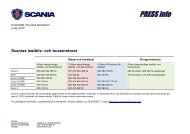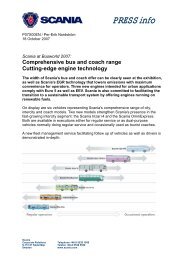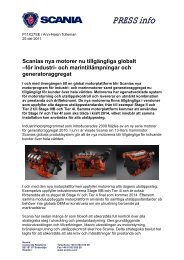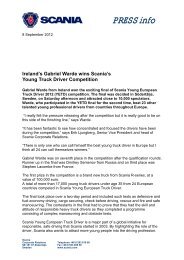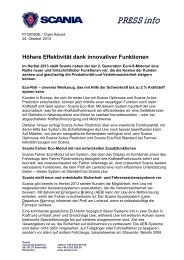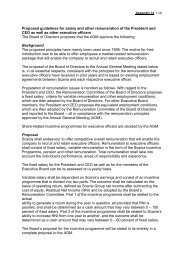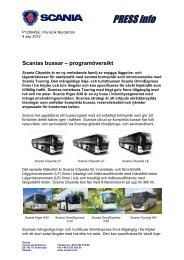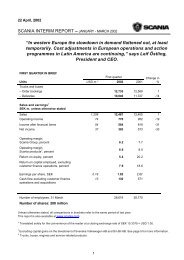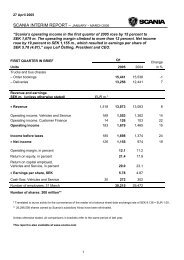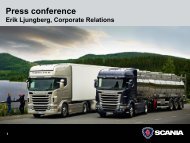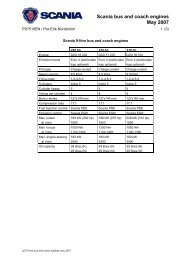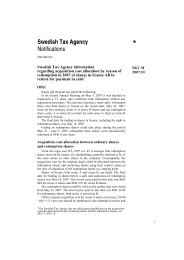Scania Annual Report 2011
Scania Annual Report 2011
Scania Annual Report 2011
You also want an ePaper? Increase the reach of your titles
YUMPU automatically turns print PDFs into web optimized ePapers that Google loves.
88<br />
notes to the consolidated financial statements<br />
NOTE 1 Accounting principles, continued<br />
BALANCE SHEET – VALUATION PRINCIPLES<br />
Tangible non-current assets including lease assets<br />
Tangible fixed assets are carried at cost minus accumulated depreciation<br />
and any impairment losses. A non-current asset is divided up<br />
into components, each with a different useful life (depreciation period),<br />
and these are reported as separate assets.<br />
Machinery and equipment as well as lease assets have useful lives<br />
of 3–12 years. The average useful life of buildings is 40 years, based on<br />
50–100 years for frames, 20–40 years for frame supplements and inner<br />
walls, 20–40 years for installations, 20–30 years for exterior surface<br />
layer s and 10–15 years for interior surface layers. Land is not depreciated.<br />
Depreciation occurs mainly on a straight-line basis over the<br />
estimated useful life of an asset, and in those cases where a residual<br />
value exists, the asset is depreciated down to this value. Useful life and<br />
depreciation methods are examined regularly and adjusted in case of<br />
changed circumstances.<br />
Borrowing costs are included in the cost of assets that take a substantial<br />
period of time to get ready.<br />
Intangible non-current assets<br />
<strong>Scania</strong>’s intangible assets consist of goodwill, capitalised expenditures<br />
for development of new products and software. Intangible non-current<br />
assets are accounted for at cost less any accumulated amortisation<br />
and impairment losses. Borrowing costs are included in the cost of<br />
assets that take a substantial period of time to get ready.<br />
Goodwill<br />
Goodwill arises when the cost of shares in a subsidiary exceeds the<br />
fair value of that company’s acquired identifiable assets and liabilities<br />
according to the acquisition analysis. Recognised goodwill has arisen<br />
from acquisitions of distribution and dealer networks, which have<br />
resulted in increased profitability upon their integration into the <strong>Scania</strong><br />
Group. Goodwill has an indefinite useful life and impairment testing is<br />
done at least yearly.<br />
Capitalised product development expenditures<br />
<strong>Scania</strong>’s research and development activities are divided into a concept<br />
phase and a product development phase. Expenditures during the<br />
concept phase are charged to earnings as they arise. Expenditures<br />
during the product development phase are capitalised, beginning on<br />
the date when the expenditures are likely to lead to future economic<br />
benefits. This implies that it is technically possible to complete the<br />
intangible asset, the company has the intention and the potential to<br />
complete it and use or sell it, there are adequate resources to carry<br />
out development and sale, and remaining expenditures can be<br />
reliably estimated. Impairment testing occurs annually for product<br />
developmen t projects that have not yet gone into service, according to<br />
the principles stated below. The amortisation of capitalised development<br />
expenditures begins when the asset is placed in service and<br />
occurs on a straight-line basis during its estimated useful life. For<br />
capitalised product development expenditures, useful life is estimated<br />
at between three and ten years.<br />
Capitalised software development expenditures<br />
Capitalised software development expenditures include expenditures<br />
directly attributable to completion of the software. They are amortised<br />
on a straight-line basis during the useful life of the software, which is<br />
estimated at between three and five years.<br />
Impairment testing of non-current assets<br />
The carrying amounts of <strong>Scania</strong>’s intangible and tangible assets as well<br />
as its shareholdings are tested on every closing day to assess whether<br />
there is indication of impairment. This includes intangible assets with<br />
an indeterminable useful life, which refer in their entirety to goodwill.<br />
The carrying amounts for goodwill and intangible assets that have not<br />
yet gone into service are tested at the end of every year regardless of<br />
whether there is an indication of impairment loss or not.<br />
If there is any indication that a non-current asset has an impairment<br />
loss, the recoverable amount of the asset is estimated. The recoverable<br />
amount of the asset is its fair value minus costs to sell or value in use,<br />
whichever is higher. Value in use is an estimate of future cash flows that<br />
is discounted by an interest rate that takes into account risk for that<br />
specific asset. If it is not possible to attribute essentially independent<br />
cash flows to an individual asset, during impairment testing assets shall<br />
be grouped at the lowest level where it is possible to identify essentiall y<br />
independent cash flows, a “cash-generating unit”. In impairment<br />
testing, the carrying amount in the balance sheet is compared to the<br />
estimated recoverable amount.<br />
In cases where the estimated recoverable amount of an asset or<br />
cash-generating unit is less than the carrying value, it is written down<br />
to the recoverable amount. An impairment loss is recognised in the<br />
income statement.<br />
Inventories<br />
Inventories are carried at the lower of cost and net realisable value<br />
according to the first in, first out (FIFO) principle. An allocable portion of<br />
indirect expenses is included in the value of the inventories, estimated<br />
on the basis of normal capacity utilisation.<br />
Financial assets and liabilities<br />
Financial instruments are any form of contract that gives rise to a financial<br />
asset in one company and a financial liability or equity instrument<br />
in another company. This encompasses cash and cash equivalents,<br />
interes t-bearing receivables, trade receivables, trade payables, borrowings<br />
and derivative instruments. Cash and cash equivalents consist of<br />
cash and bank balances as well as current (short-term) liquid investments<br />
with a maturity amounting to a maximum of 90 days, which are<br />
subject to an insignificant risk of fluctuations in value. “Current investments”<br />
consist of investments with a longer maturity than 90 days.<br />
financial reports <strong>Scania</strong> <strong>2011</strong>



